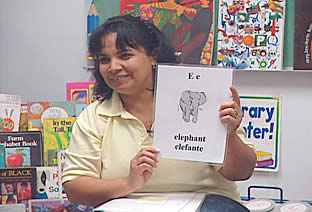 Bilingual
alphabet posters are also good ways to support young English language
learners. Including a bilingual alphabet helps children to visually connect
initial sounds, letters, and letter names. Because of differences in
the pronunciation and the initial sounds of words in English, you should
check the alphabet poster to make sure that the concept is the same and
that words in both languages begin with the same initial sound. A good
way to ensure that the translations are correct and appropriate might
be to ask the child’s family or other staff in your program who speak
the language.
Bilingual
alphabet posters are also good ways to support young English language
learners. Including a bilingual alphabet helps children to visually connect
initial sounds, letters, and letter names. Because of differences in
the pronunciation and the initial sounds of words in English, you should
check the alphabet poster to make sure that the concept is the same and
that words in both languages begin with the same initial sound. A good
way to ensure that the translations are correct and appropriate might
be to ask the child’s family or other staff in your program who speak
the language.
A technique that illustrates these suggestions is given in the Director’s Corner at the end of this section. The director used bilingual alphabet cards to complete an activity with children who are working to master the English language. This idea could provide insight for activities to assist the children in your program. For example, you may want to create your own special alphabet wall based on activities experienced by the children. Write the words using two different colors to help them see the difference between the languages. Be sure to add pictures, drawings, or photos to help convey the concept. Like any materials in your classroom, these serve as a reference children can use on their own. Selecting quality materials that reflect what is being explored is essential. For young English language learners, visual materials serve as a source of information about classroom routines, lesson themes, ideas, and experiences.